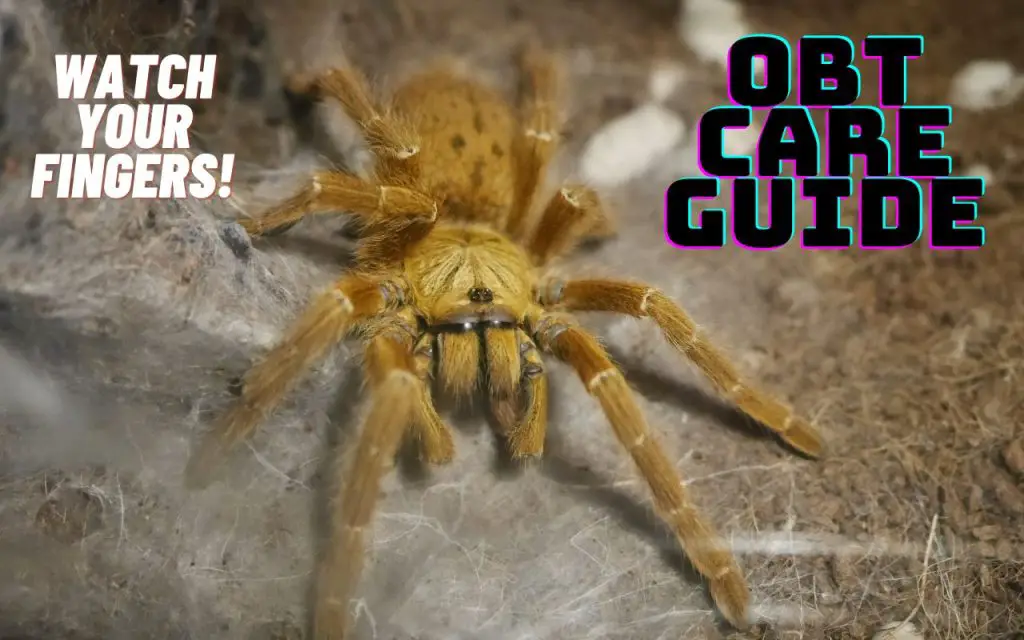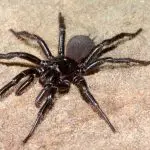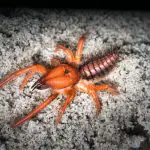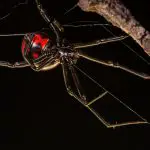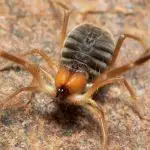Today, I want to share my experience and knowledge of one of the most visually striking tarantulas in my collection: the Orange Baboon Tarantula, also known as OBT or Pterinochilus murinus. Despite its bright appearance and intriguing behavior, this spider is not recommended for beginners due to its defensiveness and speed. But for seasoned keepers, the OBT can be an exciting challenge.
We’ll take a detailed look at how to care for this species. But first, let me just remind you that OBT doesn’t just stand for Orange Baboon Spider – it also stands for “orange bitey thing!” Trust me, this species lives up to the nickname.
Enclosure and Setup
With an adult size of around 4 to 5 inches, an Orange Baboon Tarantula doesn’t require an enormous amount of space. I find a 10-gallon tank is more than enough. This tank can be in glass or acrylic, so long as it gives the spider enough space to burrow.
It’s important to provide a fair amount of substrate (around 4-5 inches) as the OBT loves to dig. I use any substrate that holds its shape, and retains humidity well.
Here’s a list of everything you’ll need for your spider:
- A glass or acrylic enclosure
- Substrate, like Eco Earth or a pre-mixed substrate
- A water dish
- Hiding places
- Decorations (optional, but I like to add them)
- A spray bottle for misting
Orange Baboon Tarantula Humidity
Humidity is crucial when it comes to tarantula care. For the OBT, aim for a humidity level around 70-80%. This can be maintained by misting the enclosure lightly once or twice a week and always having fresh water available.
Orange Baboon Tarantula Temperature
The OBT hails from the warmer regions of Africa, so they appreciate a toasty environment. I keep my enclosure between 78 to 82 degrees Fahrenheit. Remember to monitor the temperature regularly to prevent overheating.
If your house gets cooler than 75F during the winter, you can either put a storage heater in your tarantula room, or stick a 5 watt heat mat to one side of the enclosure.
Remember, it’s best to never put a heat mat under the enclosure due to the risk of dehydrating the substrate and desiccating/cooking your tarantula.
Orange Baboon Tarantula Temperament
Here’s where the OBT stands out! They are known for their defensive nature and will not hesitate to exhibit a threat posture or even bite if they feel threatened. Although I’ve grown fond of my OBT’s feisty nature, I recommend minimal handling to avoid unnecessary stress (for both you and the spider).
If you are looking for a pet tarantula that you can handle, I would suggest a New World species such as the Arizona Blonde, Texas Tan, or even the Goliath Birdeater.
Orange Baboon Tarantula Diet
Feeding an OBT is relatively straightforward. They’re not particularly picky eaters, and they have a robust appetite. Here’s a simple feeding schedule I follow for my adult OBT:
| Week 1 | Week 2 | Week 3 | Week 4 |
|---|---|---|---|
| 2-3 Crickets | 2-3 Mealworms | 1-2 Superworms | Fasting |
Adjust the schedule as needed. Younger spiders will require more frequent feeding. Tou can also offer Dubia Roaches, Wax Worms, or Hornworms. Personally, I would also recommend getting some feeding tongs like the ones below for putting prey into the enclosure.

Orange Baboon Tarantula Lifespan
The OBT has an average lifespan of about 10-12 years for females, with males typically living around 3-4 years. It’s essential to consider this commitment before bringing one home.
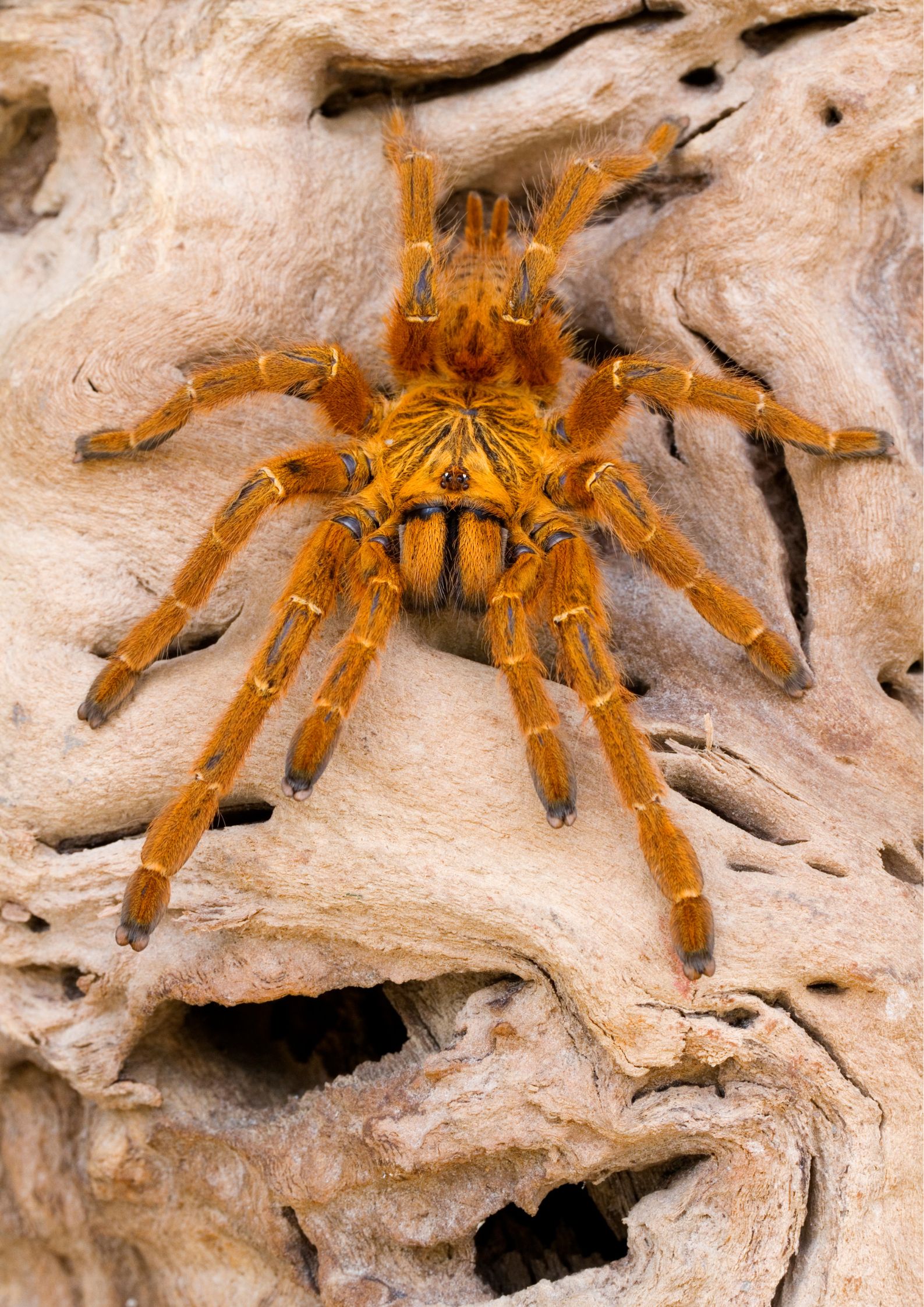
Orange Baboon Tarantula Health Issues
Just like any pet, the OBT can experience a few health issues. The most common include dehydration and injuries from molting. Regularly monitoring, ensuring optimal enclosure conditions, and providing a balanced diet can prevent these problems.
Orange Baboon Tarantula Bite
An OBT bite is something you’d want to avoid. Though not life-threatening to humans, it can cause severe pain, discomfort, and possible allergic reactions. With my OBT, I always use caution and respect its space.
Final Thoughts…
Why I like this species:
- If you get a good example, the orange coloration is outstanding! It is probably one of the most beautiful tarantulas available.
- Being a medium-sized species, the OBT has simple enclosure and care requirements
- It has a voracious appetite, making feeding time pretty entertaining
Things to consider before buying:
- These spiders are particularly ill-tempered. Don’t even think about handling them. Oh, and watch out when it comes to re-homing one – you’ll have an angry, lightning-fast tarantula on your hands!
- The effect of their venom varies from one individual to another, and some people have reported severe pain
Bringing an Orange Baboon Tarantula into your life can be a truly rewarding experience. Despite their reputation for defensiveness, they are mesmerizing creatures with vibrant colors and fascinating behaviors. I consider it a privilege to care for such a unique creature in my arachnid collection.
Really, it is obvious that this isn’t a pet you can handle. If I’m honest, though, many arachnids aren’t suitable for handling, anyway. Some spiders are display pets only, but that doesn’t make owning them any less worthwhile. I would still put the OBT on a list of the best pet spiders out there for slightly more experienced keepers.
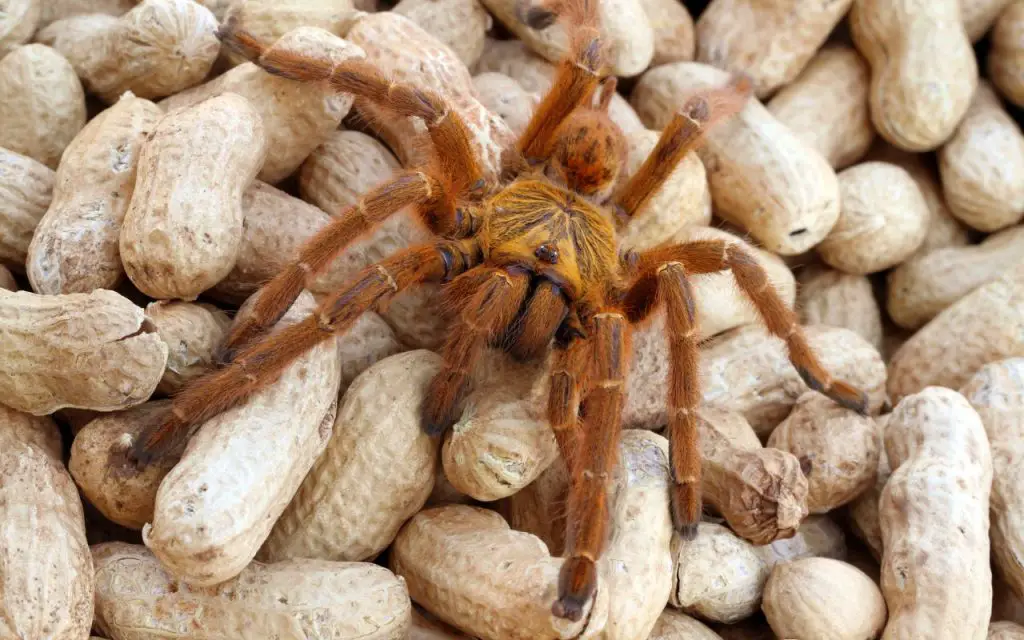
Is Orange Baboon Tarantula good for beginners?
Personally, I do not recommend the OBT for beginners. It has an irritable nature, and is quick to bite whenever it feels threatened. This is fine if you never open the tub asides from feeding. If you need to re-house the spider in a bigger enclosure, on the other, you will need previous experience handling tarantulas.
Are OBT tarantulas aggressive?
OBT tarantulas are technically highly defensive, rather than aggressive. They won’t follow you and chase you down to attack you. Instead, they perceive any large animal that approaches them – human or other – as an imminent threat and defend themselves as quickly as they can.
How venomous is an OBT?
Honestly, reports of bites vary so greatly that it is hard to know for sure exactly how venomous this species is. What is certain is that some keepers have reported intense pain and muscle cramps following a bite, and in at least one case this was recorded in medical literature.
Can you handle an OBT tarantula?
You really can’t handle an OBT. They just don’t like it, and won’t hesitate to defend themselves if you try! The reason for this is that in the wild they are one of the favorite prey items of baboons and other large mammals. They have a strong instinct to defend themselves when a larger animal approaches.

